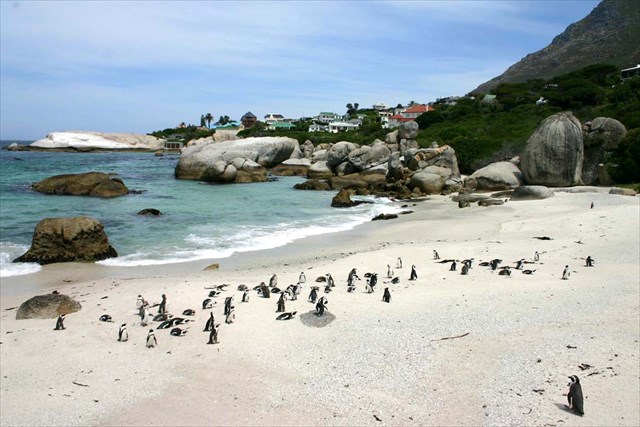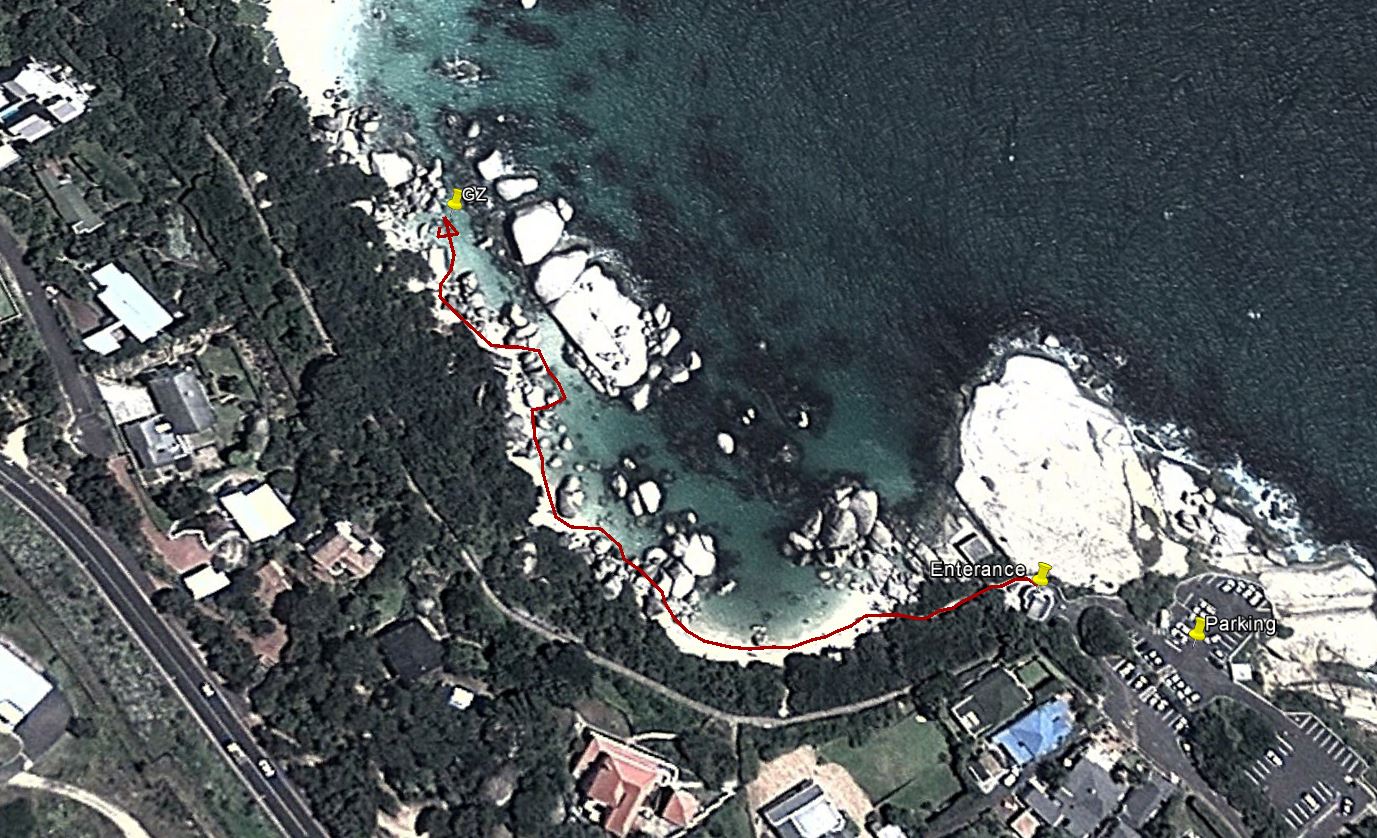Boulders Beach EarthCache
-
Difficulty:
-

-
Terrain:
-

Size:  (other)
(other)
Please note Use of geocaching.com services is subject to the terms and conditions
in our disclaimer.
Boulders Beach in Simon’s Town is ideal for kids as immense boulders shelter the cove from currents and large waves - but please always take care. Also, don't touch or feed the penguins. They might look cute and cuddly but their beaks are as sharp as razors and if they feel threatened they have no qualms about nipping the odd finger or nose.
Now on to the cache.
Please Use the Way-points provided to get your self to GZ. If you go to the wrong entrance you will not be able to get to GZ and will not be able to claim your find. 
Infomation regarding this Earth cache
Xenolith A xenolith (Ancient Greek: “foreign rock”) is a rock fragment which becomes enveloped in a larger rock during the latter's development and hardening. In geology, the term xenolith is almost exclusively used to describe inclusions in igneous rock during magma emplacement and eruption. Xenoliths may be engulfed along the margins of a magma chamber, torn loose from the walls of an erupting lava conduit or explosive diatreme or picked up along the base of a flowing lava on Earth's surface. A xenocryst is an individual foreign crystal included within an igneous body. Examples of xenocrysts are quartz crystals in a silica-deficient lava and diamonds within kimberlite diatremes. Although the term xenolith is most commonly associated with igneous inclusions, a broad definition could include rock fragments which have become encased in sedimentary rock. Xenoliths are sometimes found in recovered meteorites. To be considered a true xenolith, the included rock must be identifiably different from the rock in which it is enveloped; an included rock of similar type is called an autolith or a cognate inclusion. Xenoliths and xenocrysts provide important information about the composition of the otherwise inaccessible mantle. Basalts, kimberlites, lamproites and lamprophyres, which have their source in the upper mantle, often contain fragments and crystals assumed to be a part of the originating mantle mineralogy. Xenoliths of dunite, peridotite and spinel lherzolite in basaltic lava flows are one example. Kimberlites contain, in addition to diamond xenocrysts, fragments of lherzolites of varying composition. The aluminium-bearing minerals of these fragments provide clues to the depth of origin. Calcic plagioclase is stable to 25 km depth. Between 25 km and about 60 km, spinel is the stable aluminium phase. At depths greater than about 60 km, dense garnet becomes the aluminium-bearing mineral. Some kimberlites contain xenoliths of eclogite, which is considered to be the high-pressure metamorphic product of oceanic basaltic crust, as it descends into the mantle along subduction zones (Blatt, 1996).
References
Blatt, Harvey, and Robert J. Tracy (1996). Petrology (2nd ed.). W. H. Freeman. ISBN 0-7167-2438-3. Nixon, Peter H. (1987). Mantle Xenoliths. J. Wiley & Sons. ISBN 0-471-91209-3.
Aplite
Aplite /ˈæplaɪt/ in petrology, the name given to intrusive rock in which quartz and feldspar are the dominant minerals. Aplites are usually very fine-grained, white, grey or pinkish, and their constituents are visible only with the help of a magnifying lens. Dykes and threads of aplite are commonly observed traversing granitic bodies; they occur also, though less frequently, in syenites, diorites, quartz-diabases and gabbros. Aplites usually have a genetic affinity to the rocks they intersect. The aplites of granite areas, for example, are the last part of the magma to crystallize, and correspond in composition to the quartzo-feldspathic aggregates that fill up the interspaces between the early minerals in the main body of the rock. They bear a considerable resemblance to the eutectic mixtures which are formed on the cooling of solutions of mineral salts, and remain liquid till the excess of either of the components has separated out, finally solidifying en masse when the proper proportions of the constituents and a suitable temperature are reached. The essential components of aplites are quartz and alkali feldspar (the latter usually orthoclase or microperthite), microcline and albite. Crystallization has been apparently rapid (as the rocks are so fine-grained), and the ingredients have solidified almost at the same time. Hence their crystals are rather imperfect and fit closely to one another in a sort of fine mosaic of nearly equi-dimensional grains. Porphyritic feldspars occur occasionally and quartz more seldom; but the relation of the aplites to quartz-porphyries, granophyres and felsites is very close, as all these rocks have nearly the same chemical composition. The aplites associated with diorites and quartz-diabases differ in minor respects from the common aplites which accompany granites. The accessory minerals of these rocks are principally oligoclase, muscovite, apatite and zircon. Biotite and all ferromagnesian minerals rarely appear in them, and never in considerable amounts. Riebeckite-granites have close affinities to aplites, shown especially in the prevalence of alkali feldspars. Tourmaline also occurs in some aplites. The rocks of this group are very frequent in all areas where masses of granite are known. They form dykes and irregular veins which may be only a few inches or many feet in diameter. Less frequently aplite forms stocks or bosses, or occupies the edges or irregular portions of the interior of outcrops of granite. The syenite-aplites consist mainly of alkali feldspar; the diorite-aplites of plagioclase; there are nepheline-bearing aplites which intersect some elaeolite-syenites. In all cases they bear the same relation to the parent masses. By increase of quartz, aplites pass gradually, in a few localities, through highly quartzose modifications into quartz veins.
References
This article incorporates text from a publication now in the public domain: Chisholm, Hugh, ed. (1911). Encyclopædia Britannica (11th ed.). Cambridge University Press
Granite is a common and widely occurring type of intrusive, felsic, igneous rock. Granite has a medium to coarse texture, occasionally with some individual crystals larger than the groundmass forming a rock known as porphyry. Granites can be pink to dark gray or even black, depending on their chemistry and mineralogy. Outcrops of granite tend to form tors, and rounded massifs. Granites sometimes occur in circular depressions surrounded by a range of hills, formed by the metamorphic aureole or hornfels. Granite is nearly always massive (lacking internal structures), hard and tough, and therefore it has gained widespread use as a construction stone. The average density of granite is 2.75 g/cm3 and its viscosity at standard temperature and pressure is ~4.5 • 1019 Pa·s.
When you get to GZ you will see a large rock in front of you if you are facing NNW. The questions below are regarding this rock.
To log this one you will need to answer the following.
1: Is this a Aplite intrusion or A xenolith. Please explain your answer.
2: Estimate the average height of the Aplite intrusion or xenolith
3: At GZ you will find a Warning sign just to the right of the rock feature. What is the wording on this sign.
Please email me your answers. Do not post them with your log.
You are welcome to log your visit before you get confirmation from us, however, logs without emails will be deleted.
It would also be nice to know if you in counted any penguins or any other animals .(this is not a requirement)
Please could you post some pictures of boulders beach and the penguins . (this is not a requirement) Please no photos of GZ.
A nice easy earth cache. Please note the following .
Gz is at Boulders beach and you will need to pay to get in.
NB!! this site is only accessible at low tide, if you do not want to swim to GZ.
Path to GZ. 
(Acknowledgments: PROF. CHRIS HARRIS Department of Geological Sciences UCT . Thanks for your help with this one).
Additional Hints
(Decrypt)
Cyrnfr rznvy zr lbhe nafjref.
snzvylorueraf007@tznvy.pbz